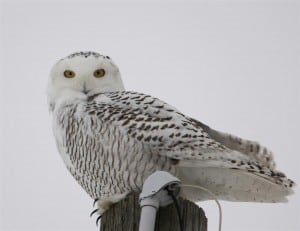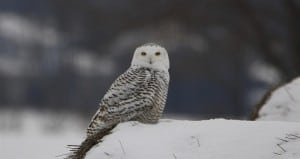The Snowy Owl is still in the Chemong Road/County Road 19 (Line Road 3) area. It was sitting on a bale of hay beside McLeod’s water treatment today, December 19. I got some nice pictures! At 2:30 p.m. the bird flew down towards the farm across from Subaru/Hyundai.
Jeff Keller
Snowy Owls are staging an incredible invasion this year with reports coming in from Atlantic Canada, the Northeast U.S., and Great Lakes, with several as far south as North Carolina and a pioneering owl out to sea on Bermuda. Possibly five different birds have been seen in the Peterborough area.
- These invasions are thought to occur because of variations in cyclical prey and predator populations in the Arctic, but the exact dynamics behind the movement still are rather poorly understood
- The movements are fascinating and engaging for birders and the general public alike.
- Snowy Owls and other predators have cyclical populations linked to prey abundance. Lemming population cycles likely drive much of the survivorship and breeding success of Snowy Owls. We know Snowy Owls will skip breeding seasons when prey is scarce and may produce large clutches (up to 9 eggs!) when prey is abundant.
- Although lemming scarcity is often implicated in Snowy Owl invasions, a bigger driving force may be highly productive breeding seasons (with multiple young fledged per pair). Periods of summer lemming abundance thus may drive these invasions more than lemming scarcity.
- The high proportion of first-winter (immature) owls during most invasions provides evidence that high breeding productivity is a major factor in these invasions.
- Snowy Owls are highly mobile. In addition to winter movements, they may move over 1000 km across the Arctic in summer. This is presumably a strategy for the birds to locate areas with abundant rodent prey for their young.
- In addition to rodents, Snowy Owls eat lots of birds, especially small waterbirds like ducks and even alcids … many owls on the Great Lakes and Atlantic coast prey heavily on waterbirds, flying out over the water to hunt them, especially at dusk.
-
This year’s invasion, focused on the eastern North America, suggests that breeding conditions may have been excellent in the eastern Arctic this past summer. The southward push we are seeing now might be driven both by Snowy Owls from far and wide that bred in the eastern Arctic, as well as higher than normal numbers of young being fledged.
- Darkest birds are usually young females and the whitest birds usually adult males, it’s especially hard to determine the age and sex of intermediate birds.
- SOURCE: eBirds

